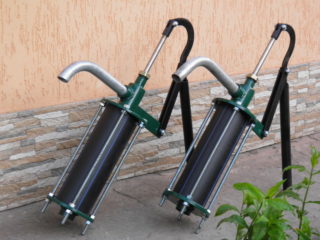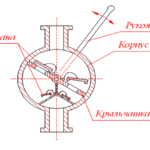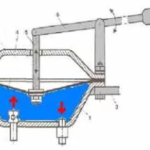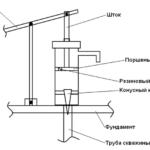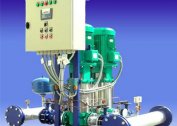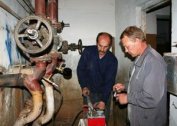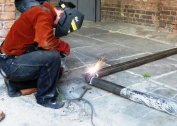It is easier and faster to use electric pumping stations, but this is not always possible. In this case, the only way to solve the problem is to install mechanical equipment for lifting water to the surface from the wells. Hand pumps are especially relevant if the owners spend little time in the house and the need for water is not so great.
Scope of the manual submersible pump
The main purpose of operating pump-type units is to pump water from the depths to specific points, for example, a garden, a house, a garage, a bathhouse, etc.
All private houses are divided into three large groups: periodic, seasonal and permanent residence. Not all of them have electricity, and some are supplied, but not on an ongoing basis.
Summarizing the listed factors, the following conclusions follow:
- In houses intended for permanent residence, there is always electricity, so it is preferable to install electric pumps to supply water. The manual model is only an auxiliary device.
- If we are talking about seasonal buildings where power lines are not connected, installing a hand pump is the best option.
You can draw water from containers with buckets, but a pump station, albeit a manual one, is more convenient.
Types of pumps, the principle of their operation and device
If the liquid mirror is located at a shallow depth and there is no need to acquire expensive electrical analogues, it is worth paying attention to mechanical pumping stations.
By the principle of their design, the pumps for the well are different.
- Membrane units are used to pump not only clean, but also dirty liquids. Jamming of mechanisms does not occur due to the equipment of a self-cleaning valve. The design lacks rubbing parts that could wear out quickly. This has a good effect on the duration and productivity of the work. The liquid suction height is not more than 6 meters.
- Vane - self-priming structures (up to 1 meter), which consist of several valves, body, shaft, wing, suction element and lever. Designed for pumping liquids without the content of solid particles, edible oils, alcohol and liquid fuels. In the Russian market, the cost starts from 4000-5000 rubles.
- Sucker rod pumps are capable of lifting liquids from depths up to 30 meters. They have a similar design and piston. The only difference is a more elongated piston shape. The disadvantages of the unit are the bulkiness, as well as the likelihood of a break in the bar.
- Piston pumping stations create outlet pressure. Cases are made, as a rule, of stainless steel, and other parts are made of fluoroplastic. They will not be able to pump water from deep wells, but they will easily replace surface electric pumps.
- Winged
- Barbell
- Membrane
- Piston
Hydraulic pumping stations are famous for their compact size. The weight of the structure is only 4 kg.
Criterias of choice
For many, the fundamental criterion for choosing pumping equipment is reasonable cost. But this is the wrong approach, at the time of purchase of the hand pump, the following criteria are important:
- Well depth. Conventionally, mechanical pumping stations are divided into two large groups: devices designed to lift liquids from a depth of 30 meters, and mechanisms operating at a depth of 6 meters.
- Borehole diameter. Experts strongly advise making a well with a diameter of more than 4 inches. This will allow in the future to install any pump.
- The degree of contamination and the nature of the liquid. There are modifications designed to work with contaminated and clean water, this can be found in the attached documentation.
- Goals.Due to technical limitations, not every mechanical pump will satisfy all the needs of the owner.
- Time of use - this moment is important, because there are units that are designed only for work in the warm period. If water supply is needed year-round, you should purchase a more expensive model.
For some people, the attractiveness of the unit plays a role. Most cases are made of cast iron and have good external data.
Installation of a manual water pump for wells and wells
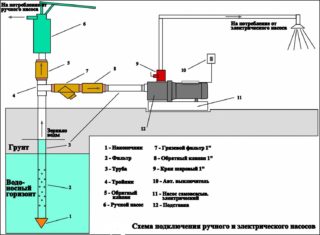 Difficulties in the installation of a manual water pump should not arise, the procedure is simple and does not require special skills.
Difficulties in the installation of a manual water pump should not arise, the procedure is simple and does not require special skills.
To install a manual pumping station, the following algorithm of actions is required:
- Check the package, all the attached parts must be in place.
- The pump casing is installed in a vertical position so that the lower part is immersed in water.
- If the attached user manual says that the device is not intended for pumping water with a high content of solid impurities, additionally install cleaning filters.
- The structure must be fixed to the surface of the earth so that it stands firmly and steadily.
- Bleed the pump so that the inside is flushed with plenty of clean water.
The installation area is recommended to choose as even as possible, stones and other debris are pre-cleaned.
Advantages and disadvantages
The mechanical method of raising water has a number of advantages and disadvantages. Before purchasing a manual pump station, you need to carefully read them.
Device Advantages:
- Easy to install, operate and maintain.
- Saving money. To raise water to the surface, a person exerts physical effort; connection to the power grid is not required.
- The design consists of working units, which, if necessary, can be replaced with new ones. Thanks to this feature, it is possible to maximize the life of the device.
- Affordable cost, especially in comparison with electrical counterparts.
- The hand pump housing is made of high quality stainless steel or cast iron.
Users note the following disadvantages:
- Low productivity and power. Compared to automatic counterparts, a mechanical device shows modest results in lifting liquids to the surface.
- The need to exert physical effort to lift the fluid. The process occurs by pressing the lever trigger.
Manual borehole pumps are in great demand among Russian consumers, because often this is the only way to organize water supply.
